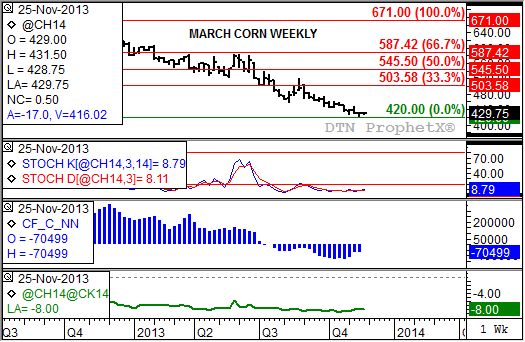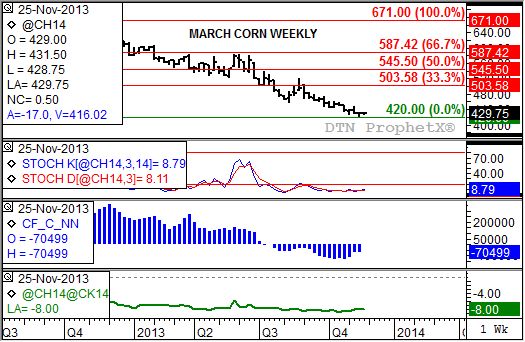Technically Speaking
March Corn Continues is Slow March
Watching the corn market erode is similar to watching the Grand Canyon, well, erode. One is slowly working lower due to a constant flow of disinterested traders, the other the workings of the Colorado River over time. Both are interesting, in their own way, with neither showing patterns of sudden change.
Given its higher open interest totals the March corn contract has assumed the role of most heavily traded from the December. And with the December contract facing first notice day this coming Friday, the day after the Thanksgiving holiday, even more attention will turn to the March contract by the weekend.
If we look at the weekly chart for March corn, we see an all too familiar pattern. The market is trending sideways to down, posting a new low every few weeks just to keep traders on their toes. The most recent such occurrence was last week, when the contract dipped to $4.20 before closing at $4.30. This week started off with a bang as the March contract posted an almost 3-cent trading range during the CME Globex session through early Monday morning. Could it be the early effects of tryptophan kicking in? Possibly.
Even though there is little going on in the corn market, a few nuggets need to be watched. First, weekly stochastics (second study) are far below the oversold level of 20%, with the faster moving blue line near 8.7% and the slower moving red line calculated near 8.1%. The fact the blue line is higher than the red line would indicate a bullish crossover has occurred, implying that the next secondary (intermediate-term) trend should be up.
As we know, trends (price movement over time) tend to reflect noncommercial activity, so if the secondary trend is turning up (possibly) it would stand to reason that the noncommercial side of the market would be buying. Weekly CFTC Commitment of Traders numbers show this group holding (week ending Tuesday, November 19) a net-short futures position of 70,499 contracts (third study, blue histogram), a slight reduction of 635 contracts from the previous week. If this group continues to cover their net-short futures position, possibly back to near par, it could be enough support to spark a modest rally in the March futures contract.
But why would this group cover their short position? For starters, the commercial outlook has grown less bearish recently. The market's view of fundamentals (supply and demand) is reflected in the trend of the futures spreads. The nearby December to March spread has seen its carry whittled from 13 cents (week of October 6) to only 6 3/4 cents as this holiday week gets under way. The move in the March to May spread (bottom study, green line) hasn't been as dramatic, but has seen the carry weaken slightly from 8 3/4 cents (week of October 21) to 8 cents. Corn's forward curve (series of futures spreads from the Dec 2013 contract through the Sept 14 contract) shows a neutral level of cost of carry (total cost of holding grain inn storage). This could be enough to spur noncommercial traders to a near flat futures position (nearly the same number of contracts sold as bought) by year's end.
If all this happens and March corn does rally, how far could it go? Technically, initial secondary resistance is pegged near $5.03 1/2, a price that marks the 33% retracement level of the previous downtrend from $6.71 through last week's low of $4.21. This seems a bit high. If we use the activity in Chicago wheat from September as guide, the upside target is trimmed considerably.
P[L1] D[0x0] M[300x250] OOP[F] ADUNIT[] T[]
In wheat, noncommercial traders went from a net-short futures position of 55,828 contracts to a net-long futures position of 10,216 contracts over the span of five weeks, rallying the December contract about 12%, coming up short of its 33% retracement target before falling again. A similar move in corn lowers the target in the March contract to about $4.70.
To track my thoughts on the markets throughout the day, follow me on Twitter: www.twitter.com\DarinNewsom






Comments
To comment, please Log In or Join our Community .